900 319 0030
enquiry@shankarias.in
AR2770 Sunspots
Solar flare
Milne ice shelf

Dwarf Planet Ceres
Mount Sinabung

Krishi Megh
National Agricultural Research & Education System
Rashtriya Krishi Vikas Yojana
Source: PIB, Indian Express